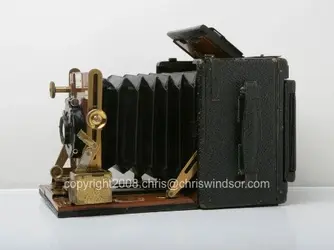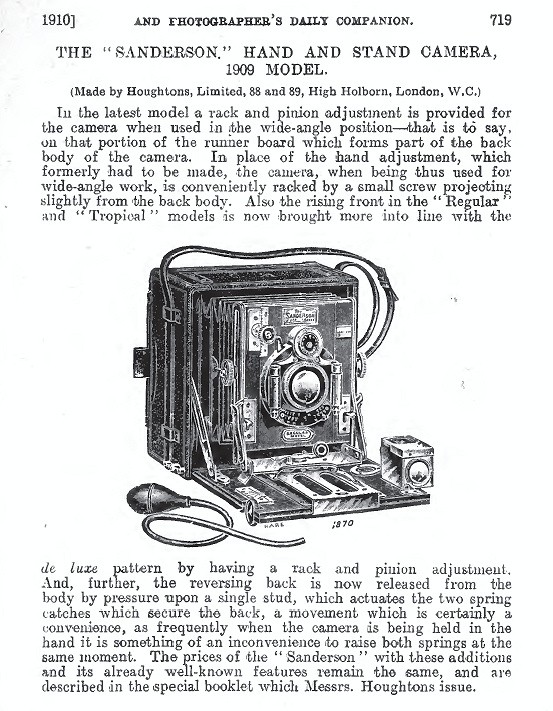I found the following info from an auction site on the web:
"Houghton-Butcher Mfg. Co., London; quarter-plate, black-leather covered body, blued-metal fittings, ebonised wood and bright-nickelled interior fittings, black leather bellows, with a Carl Zeiss, Jena Protar VII 29cm. lens no. 407576 and two double dark slides, in a fitted canvas case LITERATURE R. C. Smith (1975), Antique Cameras, p. 152. Brian Coe (1978), Cameras, pp. 38, 48-49. Edward Holmes (1974), An Age of Cameras, p. 50-52. British Journal Photographic Almanac 1901, pp. 911-913. NOTES The Sanderson range of field and hand cameras was one of the most popular and longest-lived British camera designs in production from 1895 until the second world war, with many remaining in service well into the 1960s and beyond. Frederick H. Sanderson's patent, the basis of the whole range and, in modern parlance, the unique selling point, was granted on 10 January 1895 (British patent number 613). The patent described a strut system that allowed the camera back or front to be fixed at any angle in conjunction with an adjustable lens panel. Sanderson began selling the camera until the sole rights were passed to Houghtons Ltd. who made and marketed the camera until it's demise. During the camera's history over sixty distinct models of camera were produced supported by an extensive range of lens and shutter combinations and accessories. The basic field camera design was added to in 1899 by the hand and stand Sanderson. This design went through an extensive range of minor modifications including a rollfilm version (1903) and standard and tropical versions in various plate sizes, until the 1930s when an ebonised version with chrome fittings was introduced. Along the way three different types of front standard catch were brought in, six different lens panel fixings, and body types and there were seven distinct label types amongst other variations. The first Sanderson camera appeared in late 1895 and was advertised from 1896. Houghtons took over the manufacture from 1897. Houghtons described the camera as: 'A new principle on Camera Construction... [the] Greatest advance yet made in camera construction... Distinct from every other camera on the market'. The Sanderson patented struts were claimed to do: 'away with the tilting of the camera, entirely dispenses with the swing back and in place of all the old movements and adjustments of Camera and Stand, a greater latitude between lens and plate is secured, with the power to swing the front and to compose a subject on the Ground Glass, and roughly focus it, all by one and the same action, and is controlled by two adjusting screws only, one on either side of the camera front'. From the earliest days the camera was made available in plate sizes from quarter-plate to 15 x 12 inches. The Sanderson hand camera even by 1938 was described by in the Ensign Photographic Catalogue as: 'One of the worlds most famous cameras and used extensively by most serious workers. The Sanderson embodies every possible movement that may be required for any sort of pictorial subject'. During the course of the camera's history the camera struts were numbered consecutively from three-figure numbers to a high in the 26,000 series."
So, based on the text above, the camera I found dates from the 1930s. Interesting...













![[No title]](/data/xfmg/thumbnail/34/34065-43f99c081a04bd087c00711d2fe010ee.jpg?1734164488)
![[No title]](/data/xfmg/thumbnail/37/37605-90c8efaef5b7d1f52d4bf8e7dfd33673.jpg?1734170732)



![[No title]](/data/xfmg/thumbnail/37/37604-7ad625e983f92f880eb65a264eeef5e4.jpg?1734170732)